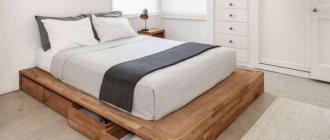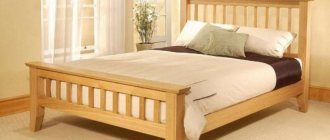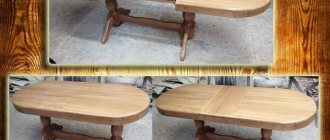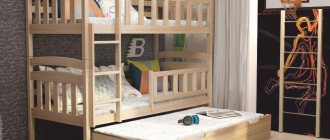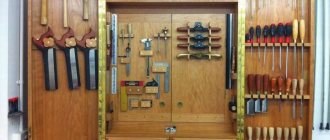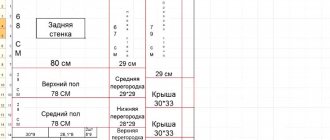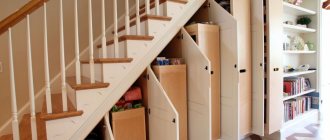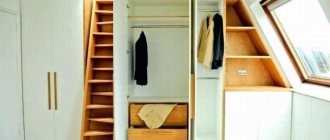DIY folding bed
It all starts with an idea. In fact, making a bed with your own hands is not such a problem; there are a lot of instructions, step-by-step photos and videos for this. What is important is that your dream bed matches the functions and aesthetic needs that you have in mind.
Here are several ideas, mainly examples of how to make folding beds with your own hands , which not only save space, but also make your home attractive. For those who like non-standard solutions, there are several options for original designs, from a medieval bed to a robot bed with step-by-step manufacturing instructions. And if you value comfort, you can learn how to make a simple bed pocket to store the remote control, mobile phone and other necessary things.
Design features of the bed
In order to understand how the bed is assembled, it is important to consider the design features in detail. Sleeping furniture has 2 main parts - the frame and the frame. The frame is made on a podium or legs. As for the frame, it can be made from natural solid wood, chipboard or metal. This is discussed in more detail at the end of the article. The slats are attached in the transverse direction. Some models are additionally equipped with lifting mechanisms that operate in manual or automatic mode.
REFERENCE! Considering that the bed takes up quite a lot of free space in the room, manufacturers strive to make it more functional by placing drawers for storing linen in the podium.
By strictly following the existing instructions and assembly diagram, you will not have any problems, even if you have never done anything like this before.
How to assemble an Ascona bed without a lifting mechanism
| 1) Attaching the lifting mechanism to the base with slats. As a rule, the first hole on the side of the headboard is drilled at a distance of 10-15 cm. and the following holes along the upper mounting bar of the lifting mechanism fall into their required places by themselves. But there is no exact definition, because... There are different lifting mechanisms from a number of manufacturers, and different types of beds with different headboards may change the position of the mechanism. In our online store there are bed base kits with a lifting mechanism, where all the necessary holes will already be drilled in the required places. After connecting the lifting mechanism to the base, the attachment points are “caught” on the side frames of the bed; to do this, you need to try the base with the mechanism in the closed position into the bed frame. The lifting mechanism can be set to open not along the length of the bed from the legs, but from the side, but it is necessary to take into account that gas springs (gas lifts) in this case are needed one and a half to two times weaker. It is possible to use the lifting mechanism without using an orthopedic bed base with wooden slats, i.e. use a sheet of plywood as a base, for example. |
2) Attaching the lifting mechanism to the bed frames. It must be secured to the side frames with bolts (do not use self-tapping screws - it won’t hold up, it will tear out). The bolts should preferably pass through the side frame and be secured with nuts and washers. If the outer part of the drawer is decorative and it is unacceptable to drill through, then furniture bushings are used into which the bolt is rotated (a non-through hole is drilled and a bushing - nut is inserted into it). You can find many videos on YouTube on this topic to see clearly.
3) Installing the base (frame) with slats into the bed. There are different types of raised beds; the base can be sunk inside the box or placed on top of it. If the base with slats under the mattress is sunk, then metal corners are attached to the inner corners of the bed on which the frame is placed on the side of the legs; often these corners are already in the beds as corner fastenings. In addition to the corners, there are other holders - for example, a plastic frame stopper, which rotates onto the inner drawers of the bed from the side of the legs. The bed frame should be divided into two parts by a central drawer. Both horizontal and vertical divisions are allowed. The central drawer is necessary for beds with a lifting mechanism with a width of 140 cm or more. it acts as a support for the base (frame) in the center; if it is absent on wide beds, the frame can simply bend in the center. For example, bed bases with a width of 140 cm or more without a lifting mechanism on legs (supports) have, in addition to the corner ones, a central fifth support. Sometimes two additional supports are placed in the center. If the base is placed on the drawers, then the central drawer - the box divider (frame support) will be the same height as the perimeter of the bed; if the base is recessed, then it is lower than the perimeter at a distance from the floor (bottom) to the recessed base (frame). The bottom of the bed linen box can be made of fiberboard or plywood, or, as many manufacturers of beds do, the material is fibertex (special felt with a print).
5) Selection of gas spring (gas lift) force for the bed. There is a popular opinion that, for example, a gas lift force of 1000 N is a lift of 100 kg. This is conditional and not entirely true; there are many parameters that affect the lifting of a particular structure, such as: the lifting angle, the angle of the gas spring, the area of the lifted surface, the center of gravity of the surface. There is a special formula for selecting gas springs. But if you go into the details of the production calculation, you can derive a conditional recommendation. Many furniture factories standardly equip a bed measuring 160/200 cm with 800N gas lifts (2 pieces of 800N each, of course - on the right and left parts of the lifting mechanism), provided that a standard mattress is used. If the mattress is high and heavy (usually more expensive models), then set it to 1000N. In proportion to this, 1000N and 1200N are placed on a bed measuring 180/200 cm with a heavy mattress, and 1200N on a bed measuring 200/200 cm. And to a lesser extent: for a bed 120/200 and 140/200 cm 600N with a heavy mattress 800N. For single beds 80/200 cm 500N. If the bed opens from the side (horizontally) and not lengthwise (vertically) as usual, then on a bed of size 160/200N they put less force - 500N and in proportion to the size +/- 100/200N. For wardrobe-bed mechanisms, gas springs with a much higher force from 600 to 2000N are used, depending on the size and type of opening (horizontal or vertical). Such gas springs (from 1200N) are reinforced and are manufactured with large diameters of the rod and cylinder (14/27 mm), thickened, reinforced fasteners, due to which they are much more expensive. There is also a “Universal” lifting mechanism, its peculiarity is that with the same gas lift you can adjust (+/- 200N) the force of the gas spring by changing its angle of location in the mechanism. Whether the gas lift force is suitable for a bed or not must be tested at full load on the base, i.e. with a mattress. Without a mattress, the base may open spontaneously and the gas lift may seem too strong. Read more about gas lifts in the instructions for using gas springs. 6) Location of the gas spring in the bed lifting mechanism. As indicated in the instructions for using gas springs, it is necessary to install the gas lift in the mechanism with the rod down, because otherwise it won't last long. The gas spring contains compressed gas (nitrogen) in the cylinder, which creates rod pressure and hydraulic oil to reduce friction in the rod stroke. At the point where the rod enters the cylinder there are special gaskets (pistons) that hold the pressure. The oil in the cylinder wets the gasket from the inside and prevents it from drying out, with the inevitable appearance of microcracks through which gas under pressure will escape along with the oil and the gas spring will have to be replaced (based on the principle of storing wine in bottles at an angle). In addition, the gas lift does not need to be tightened with a nut; it must be allowed to rotate, because When opening and closing the bed, it changes its position on the fastenings.
7) Accessories. The main accessories for a bed with a lifting mechanism are a mattress holder and a strap. The mattress holder is a metal bracket that is attached to the frame (base) of the bed in the center on the side of the headboard; it serves to keep the mattress from moving when lifting (opening) the frame with the mattress to access the linen compartment. On wide beds measuring 180/200 and 200/200 cm, two pieces can be placed at an equal distance. Sometimes, mattress holders are placed on the frame and on the side of the legs and are used as a handle for opening and closing the lift-up bed. A synthetic fabric strap is usually used just on the base on the leg side to open and close the bed frame. With wardrobe-bed mechanisms, they use straps to tie the mattress with the base. There are also accessories for a bed with a lift, such as: a protective plastic mechanism box, a mechanical gas lift lock, sliders, headboard connectors and a transverse frame lock. The protective plastic box serves to protect laundry from getting into the moving parts of the lifting mechanism and plays a decorative role. Easily attached to the drawers with brackets or self-tapping screws. Headboard sliders are used to connect the headboard and the perimeter of the bed. Allows you to easily remove (unfasten) and put back (fasten) the headboard to the perimeter of the bed. The gas lift lock is used on the gas spring rod as a lock to keep the bed from closing (this lock is more of a psychological accessory, since the bed cannot suddenly fall on your head, even if the gas lift fails, the frame will slowly lower due to the second gas lift). The transverse frame clamp is an interesting and useful accessory; it is attached to the edges of the bed frame towards the legs. Serves to protect decorative upholstery from scratches that sometimes occur from the frame towards the feet when the box is frequently opened/closed. And also, this clamp occupies the gaps between the base and the drawer and does not allow the frame to play to the right or left.
Source
